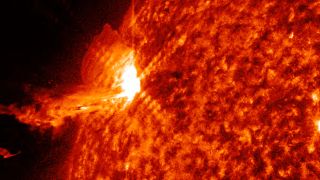As sun's most active regions turn toward Earth, potential for violent solar activity builds
Solar activity continues to climb, raising the risk of solar flares and coronal mass ejections that could affect power and communications infrastructure here on Earth.

Solar activity is set to remain high over the coming weeks as two large active regions of the sun turn to face Earth.
The regions, designated NOAA 13169 and NOAA 13170, will return from passing around the backside of the sun over the next few days, and the enormous active regions will appear on the east limb of the sun.
An active region of the sun is a place where the star's magnetic fields are disturbed. They are associated with explosive solar storms such as solar flares and coronal mass ejections (CMEs). These active regions increase as the sun heads toward the solar maximum, the period of peak activity in the solar cycle, and are indicated by dark sunspots.
Related: Previously hidden sunspot unleashes colossal X-class solar flare as it turns to face Earth
According to a statement from the National Solar Observatory (NSO), measurements of the sun indicate the increased potential for violent solar events, such as solar flares and CMEs, during this reappearance. While this space weather can interact with Earth's magnetosphere, the magnetic field that surrounds our planet, to create beautiful light shows called auroras at high latitudes, it can also have far less desirable effects.
Extreme space weather can disrupt space technology, power grids and communication systems, including GPS navigation and aircraft passing over the North Pole.
Scientists are aware of active regions of the sun even when they are unseen or near the sun's farside, thanks to an acoustic technique called helioseismic holography. Because the sun "rings like a bell" when sound waves propagate through it, researchers can use acoustics to determine what is going on at various depths of the star.
Get the Space.com Newsletter
Breaking space news, the latest updates on rocket launches, skywatching events and more!

Scientists at the NSO's Global Oscillation Network Group are using this method to look for changes in the intensity and frequency of these acoustic waves passing through the sun to study otherwise invisible regions of strong magnetic fields.
As the sound waves bounce around the interior of the sun and are reflected back and forth, they are encoded with information about unseen regions. This information can then be carried back to researchers, who can then build maps of the sun's farside and effectively "see" strongly active regions on the opposite side of the star. This information can warn scientists about the active regions that are about to move around to the nearside of the sun and thus bring violent space weather.
Currently, there are three large active regions of the sun that are in the star's southern hemisphere and facing Earth. These regions have sparked several high-energy solar flares over the past few days but will soon rotate around the west limb of the sun to transit around the back of the star.
The sun is currently in the fourth year of its current solar cycle, which began in December 2019, when the surface of the star had its lowest sunspot number, known as the solar minimum, of around 1.8. The solar cycle describes the changes the star's magnetic field undergoes over an 11-year period, and scientists track it by recording sunspot activity.
Thus far, solar cycle 25 has been more active than the relatively quiet solar cycle 24. Since December 2019, solar activity, including the number of sunspots and solar flares, has increased. The sun is heading to the next solar maximum, in 2024, when the star's polarity will reverse and many more active regions will appear.
Follow us on Twitter @Spacedotcom or on Facebook.
Join our Space Forums to keep talking space on the latest missions, night sky and more! And if you have a news tip, correction or comment, let us know at: community@space.com.

Robert Lea is a science journalist in the U.K. whose articles have been published in Physics World, New Scientist, Astronomy Magazine, All About Space, Newsweek and ZME Science. He also writes about science communication for Elsevier and the European Journal of Physics. Rob holds a bachelor of science degree in physics and astronomy from the U.K.’s Open University. Follow him on Twitter @sciencef1rst.